I travel a lot - playing tours with my band, doing field research on music - but until this year I had never taken a real vacation in years. Croatia had always been a place where I went overnight to re-enter the EU with a fresh visa. Zagreb isn't fun. Zagreb is like the " Sunday Dinner at Grandma's House" of the Balkans (Serbia is Sunday at your cousin's secret basement playroom where you tell dirty jokes and tie your friends up but then things
get out of hand when girls show up and you find your uncle's gun collection and then break into the liquor cabinet and....) Croatia is Yugoslavistan without Gypsies. Gwenyth Paltrow and Jack Nicholson have vacation homes on Hvar.
Ewww. Icky. No, Croatia had never been on my destination map. But then Fumie discovered Dalmatia. Dalmatia used to be part of the Venetian Republic, and the Italian influence is strong. And there is fish.

Last spring Whizz Air - one of the budget air lines - made an offer of
ten dollar tickets to Split from Budapest. And so, having finished my grueling ten day teaching gig at the Medem Klezmer Workshop in Paris, we were off to Split to sail around the Adriatic on this:

No, I did not sail the ship. No way. I don't drive cars, much less sail ships. Ships, however, are forever connected in my mind to Yugoslavs. The last time I was offered the chance to get on board a self propelled watercraft it was with Emil down in Florida. There was a severe storm warning out and two cases of beer and a bottle or two of Johnny Walker in the boat. I took that as agood reason to pass on getting into the boat. But this

ship was different. This ship is owned by my good buddy Dejan, who - like many Dalmatians - is a merchant seaman who works around the world as a pilot on ships that supply oil platforms. when he comes home to Dalmatia, he lives on his boat. He actually knows his way around a boat. Then one day he met Fumie's best friend Camille in Budapest, and history was made. Camille, who is from Paris, has a "relationship history" that reads like the history of Byzantium - surprisingly many cases of people being hung upside down over smoky fires with their eyes poked out,
emotionally speaking... - and so when she met Dejan it was a relief for all her friends. I mean, women are supposed to get swept away when they meet a sailor, right?
Finally, she finds a man with a yacht! We like this man. Sure, he has to go to Angola or Brazil every few months to help George Bush get more oil into American SUVs (you heard me right - the company that maintains all the oil platforms is a Bush family company) but when he is at home, Dejan uses wind power for almost all his needs. Life is simple and good when all you need are wind power, fish, a small, nuclear-powered French girlfriend, and a bottle of home brewed Travarica brandy. And maybe another bottle of Travarica.
Dejan je moj vodka brat. 
Usually when I get to former Yugoslavistan, the first thing I chow down is a plate of
cevapcici - same as
köfte, really, only slightly less refined. Served with chopped onions, pepper
ajvar, and fries.

Traveling with Fumie, however, is like traveling with a pet seal. If you want her to stay happy, you have to throw her some fish. A lot of fish. As mentioned before, when Fumie sees shellfish, such as these clams and langoustines, all notions of
sharing go flying out the door. These were hers, and hers alone. Others could go near this plate only with her permission....

We began our trip in Hvar, where we met Judit, who took the train in from Budapest. Judit had not been outside of Hungary in over a decade, but she made up for it by literally eating every living thing that swam in the Adriatic sea in a week. Never has a Hungarian eaten this much seafood in recorded history.
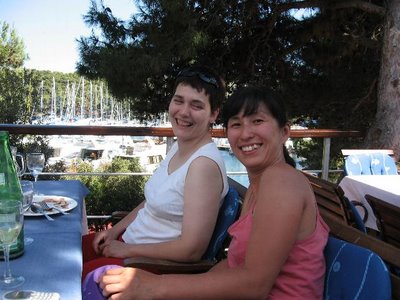
Hvar is the trendy new mother of all tourist islands, but we didn't see any celebrities, only a vast herd of German and Scandinavian touristoids, shod in pink designer flip-flops and devouring ice creams, chugging margaritas and working on future skin melanomas, so we left pretty fast to Sveti Kliment, a small island an hour sail away. Sveti Kliment has a marina and two restaurants. That's it. After the hormone filled disco atmosphere of Hvar it was a genuine relief. The local specialty was squid:

One of our stops was the island of Vis. Vis was the headquarters of Tito's partisan fighters during WWII, and subsequntly was a naval base duuring the Yugoslav years. From Vis the partizans smuggled hundreds of Jews out of Yugoslavia to British occupied Egypt, and it was here that the Allies maintained their only naval base during the Nazi occupation of Yugoslavia. Subsequently, it escaped the massive tourist developement that plagued the Dalmatian coast.
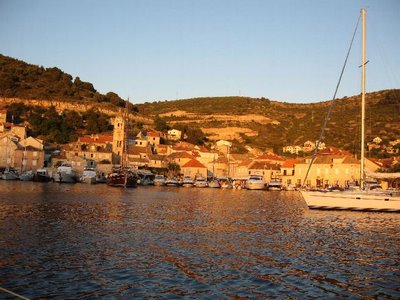
Fumie's birthday party on Vis, at the Pojoda Restaurant. The Pojoda specializes in local home style cooking - not the usual grilled fish and squid. There was seafood rissoto made from barley corns instead of rice, bean soup with a fish based broth, octopus salad, octopus burgers, fish stew...
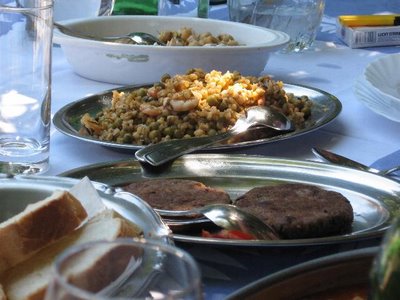
and one very happy Fumie.

Being close to water, I had to go fishing. Dejan and I had picked up some cheap salt water fishing rods in the Chinese Market in Budapest, and I finally understand why people pay more than twenty bucks for fishing rods. I'm essentially a fly fisherman, but I was raised near the Atlantic ocean, so when I get near salt water, I am fishing for
meat. It makes up for all those trout I release. Besides, trout don't taste nearly as good as sea fish.

Truth is, we actually did catch enough fish to eat. Most Croatian fishermen go after the big species or schooling fish fish that bring in big money at market, so you rarely saw small harbor fish for sale. The harbors and rocky beach coves, however, were teeming with fish. Using the mighty
Fish Base fish identification database (one of the only actually useful things existing on the internet) I was able to identify many of these fish as varieties of sea perch, wrasse, gilthead sea bream, and, well, other little fish that tasted good.

Just look at those gigantic speckled beauties! I am essentially a trout fisherman, so size, or lack of any size at all, doesn't really bother me. Dejan cooked up the catch into a fisherman's stew, which we had with pasta.

Dejan losing consciousness after eating half a roasted sheep. We had ordered lamb, but the animal that came to our table had definately been lying about its age. Still, meat is meat, and if we hadn't eaten it, we would be liable to the accusation that we were speading vegan tendancies. So we ate it. We had to. Without a full stomache, we wouldn't be able to drink as much
travarica as we wanted.
Travarica is the local home-brew: plum brandy infused with various island herbs and often flavored with heavy doses of carob.
Travarica is a pretty potent drink. It does wonders for digital photography...

 Last spring Whizz Air - one of the budget air lines - made an offer of ten dollar tickets to Split from Budapest. And so, having finished my grueling ten day teaching gig at the Medem Klezmer Workshop in Paris, we were off to Split to sail around the Adriatic on this:
Last spring Whizz Air - one of the budget air lines - made an offer of ten dollar tickets to Split from Budapest. And so, having finished my grueling ten day teaching gig at the Medem Klezmer Workshop in Paris, we were off to Split to sail around the Adriatic on this:  No, I did not sail the ship. No way. I don't drive cars, much less sail ships. Ships, however, are forever connected in my mind to Yugoslavs. The last time I was offered the chance to get on board a self propelled watercraft it was with Emil down in Florida. There was a severe storm warning out and two cases of beer and a bottle or two of Johnny Walker in the boat. I took that as agood reason to pass on getting into the boat. But this
No, I did not sail the ship. No way. I don't drive cars, much less sail ships. Ships, however, are forever connected in my mind to Yugoslavs. The last time I was offered the chance to get on board a self propelled watercraft it was with Emil down in Florida. There was a severe storm warning out and two cases of beer and a bottle or two of Johnny Walker in the boat. I took that as agood reason to pass on getting into the boat. But this  ship was different. This ship is owned by my good buddy Dejan, who - like many Dalmatians - is a merchant seaman who works around the world as a pilot on ships that supply oil platforms. when he comes home to Dalmatia, he lives on his boat. He actually knows his way around a boat. Then one day he met Fumie's best friend Camille in Budapest, and history was made. Camille, who is from Paris, has a "relationship history" that reads like the history of Byzantium - surprisingly many cases of people being hung upside down over smoky fires with their eyes poked out, emotionally speaking... - and so when she met Dejan it was a relief for all her friends. I mean, women are supposed to get swept away when they meet a sailor, right? Finally, she finds a man with a yacht! We like this man. Sure, he has to go to Angola or Brazil every few months to help George Bush get more oil into American SUVs (you heard me right - the company that maintains all the oil platforms is a Bush family company) but when he is at home, Dejan uses wind power for almost all his needs. Life is simple and good when all you need are wind power, fish, a small, nuclear-powered French girlfriend, and a bottle of home brewed Travarica brandy. And maybe another bottle of Travarica. Dejan je moj vodka brat.
ship was different. This ship is owned by my good buddy Dejan, who - like many Dalmatians - is a merchant seaman who works around the world as a pilot on ships that supply oil platforms. when he comes home to Dalmatia, he lives on his boat. He actually knows his way around a boat. Then one day he met Fumie's best friend Camille in Budapest, and history was made. Camille, who is from Paris, has a "relationship history" that reads like the history of Byzantium - surprisingly many cases of people being hung upside down over smoky fires with their eyes poked out, emotionally speaking... - and so when she met Dejan it was a relief for all her friends. I mean, women are supposed to get swept away when they meet a sailor, right? Finally, she finds a man with a yacht! We like this man. Sure, he has to go to Angola or Brazil every few months to help George Bush get more oil into American SUVs (you heard me right - the company that maintains all the oil platforms is a Bush family company) but when he is at home, Dejan uses wind power for almost all his needs. Life is simple and good when all you need are wind power, fish, a small, nuclear-powered French girlfriend, and a bottle of home brewed Travarica brandy. And maybe another bottle of Travarica. Dejan je moj vodka brat.  Usually when I get to former Yugoslavistan, the first thing I chow down is a plate of cevapcici - same as köfte, really, only slightly less refined. Served with chopped onions, pepper ajvar, and fries.
Usually when I get to former Yugoslavistan, the first thing I chow down is a plate of cevapcici - same as köfte, really, only slightly less refined. Served with chopped onions, pepper ajvar, and fries.  Traveling with Fumie, however, is like traveling with a pet seal. If you want her to stay happy, you have to throw her some fish. A lot of fish. As mentioned before, when Fumie sees shellfish, such as these clams and langoustines, all notions of sharing go flying out the door. These were hers, and hers alone. Others could go near this plate only with her permission....
Traveling with Fumie, however, is like traveling with a pet seal. If you want her to stay happy, you have to throw her some fish. A lot of fish. As mentioned before, when Fumie sees shellfish, such as these clams and langoustines, all notions of sharing go flying out the door. These were hers, and hers alone. Others could go near this plate only with her permission.... We began our trip in Hvar, where we met Judit, who took the train in from Budapest. Judit had not been outside of Hungary in over a decade, but she made up for it by literally eating every living thing that swam in the Adriatic sea in a week. Never has a Hungarian eaten this much seafood in recorded history.
We began our trip in Hvar, where we met Judit, who took the train in from Budapest. Judit had not been outside of Hungary in over a decade, but she made up for it by literally eating every living thing that swam in the Adriatic sea in a week. Never has a Hungarian eaten this much seafood in recorded history. Hvar is the trendy new mother of all tourist islands, but we didn't see any celebrities, only a vast herd of German and Scandinavian touristoids, shod in pink designer flip-flops and devouring ice creams, chugging margaritas and working on future skin melanomas, so we left pretty fast to Sveti Kliment, a small island an hour sail away. Sveti Kliment has a marina and two restaurants. That's it. After the hormone filled disco atmosphere of Hvar it was a genuine relief. The local specialty was squid:
Hvar is the trendy new mother of all tourist islands, but we didn't see any celebrities, only a vast herd of German and Scandinavian touristoids, shod in pink designer flip-flops and devouring ice creams, chugging margaritas and working on future skin melanomas, so we left pretty fast to Sveti Kliment, a small island an hour sail away. Sveti Kliment has a marina and two restaurants. That's it. After the hormone filled disco atmosphere of Hvar it was a genuine relief. The local specialty was squid:  One of our stops was the island of Vis. Vis was the headquarters of Tito's partisan fighters during WWII, and subsequntly was a naval base duuring the Yugoslav years. From Vis the partizans smuggled hundreds of Jews out of Yugoslavia to British occupied Egypt, and it was here that the Allies maintained their only naval base during the Nazi occupation of Yugoslavia. Subsequently, it escaped the massive tourist developement that plagued the Dalmatian coast.
One of our stops was the island of Vis. Vis was the headquarters of Tito's partisan fighters during WWII, and subsequntly was a naval base duuring the Yugoslav years. From Vis the partizans smuggled hundreds of Jews out of Yugoslavia to British occupied Egypt, and it was here that the Allies maintained their only naval base during the Nazi occupation of Yugoslavia. Subsequently, it escaped the massive tourist developement that plagued the Dalmatian coast. Fumie's birthday party on Vis, at the Pojoda Restaurant. The Pojoda specializes in local home style cooking - not the usual grilled fish and squid. There was seafood rissoto made from barley corns instead of rice, bean soup with a fish based broth, octopus salad, octopus burgers, fish stew...
Fumie's birthday party on Vis, at the Pojoda Restaurant. The Pojoda specializes in local home style cooking - not the usual grilled fish and squid. There was seafood rissoto made from barley corns instead of rice, bean soup with a fish based broth, octopus salad, octopus burgers, fish stew... and one very happy Fumie.
and one very happy Fumie. Being close to water, I had to go fishing. Dejan and I had picked up some cheap salt water fishing rods in the Chinese Market in Budapest, and I finally understand why people pay more than twenty bucks for fishing rods. I'm essentially a fly fisherman, but I was raised near the Atlantic ocean, so when I get near salt water, I am fishing for meat. It makes up for all those trout I release. Besides, trout don't taste nearly as good as sea fish.
Being close to water, I had to go fishing. Dejan and I had picked up some cheap salt water fishing rods in the Chinese Market in Budapest, and I finally understand why people pay more than twenty bucks for fishing rods. I'm essentially a fly fisherman, but I was raised near the Atlantic ocean, so when I get near salt water, I am fishing for meat. It makes up for all those trout I release. Besides, trout don't taste nearly as good as sea fish. Truth is, we actually did catch enough fish to eat. Most Croatian fishermen go after the big species or schooling fish fish that bring in big money at market, so you rarely saw small harbor fish for sale. The harbors and rocky beach coves, however, were teeming with fish. Using the mighty Fish Base fish identification database (one of the only actually useful things existing on the internet) I was able to identify many of these fish as varieties of sea perch, wrasse, gilthead sea bream, and, well, other little fish that tasted good.
Truth is, we actually did catch enough fish to eat. Most Croatian fishermen go after the big species or schooling fish fish that bring in big money at market, so you rarely saw small harbor fish for sale. The harbors and rocky beach coves, however, were teeming with fish. Using the mighty Fish Base fish identification database (one of the only actually useful things existing on the internet) I was able to identify many of these fish as varieties of sea perch, wrasse, gilthead sea bream, and, well, other little fish that tasted good.  Just look at those gigantic speckled beauties! I am essentially a trout fisherman, so size, or lack of any size at all, doesn't really bother me. Dejan cooked up the catch into a fisherman's stew, which we had with pasta.
Just look at those gigantic speckled beauties! I am essentially a trout fisherman, so size, or lack of any size at all, doesn't really bother me. Dejan cooked up the catch into a fisherman's stew, which we had with pasta. Dejan losing consciousness after eating half a roasted sheep. We had ordered lamb, but the animal that came to our table had definately been lying about its age. Still, meat is meat, and if we hadn't eaten it, we would be liable to the accusation that we were speading vegan tendancies. So we ate it. We had to. Without a full stomache, we wouldn't be able to drink as much travarica as we wanted. Travarica is the local home-brew: plum brandy infused with various island herbs and often flavored with heavy doses of carob. Travarica is a pretty potent drink. It does wonders for digital photography...
Dejan losing consciousness after eating half a roasted sheep. We had ordered lamb, but the animal that came to our table had definately been lying about its age. Still, meat is meat, and if we hadn't eaten it, we would be liable to the accusation that we were speading vegan tendancies. So we ate it. We had to. Without a full stomache, we wouldn't be able to drink as much travarica as we wanted. Travarica is the local home-brew: plum brandy infused with various island herbs and often flavored with heavy doses of carob. Travarica is a pretty potent drink. It does wonders for digital photography...
 Most Europeans define a hamburger as something bought at McDonald's, and while everybody claims to hate Micky D's all the McDonald's in Europe are packed to the gills with long lines at the counter. Some burgers become strange five-star chef's fusion creations, with a hint of Thai, a whiff of Provence, artisanal cheese, but it still ain't no Hamburger Mary's. A big, juicy cheeseburger of the type that used to nourish me and my bro at Louie's Charcoal Pit or the Allston Grille has eluded me all over this continent. Heck, I used to have breakfast at the
Most Europeans define a hamburger as something bought at McDonald's, and while everybody claims to hate Micky D's all the McDonald's in Europe are packed to the gills with long lines at the counter. Some burgers become strange five-star chef's fusion creations, with a hint of Thai, a whiff of Provence, artisanal cheese, but it still ain't no Hamburger Mary's. A big, juicy cheeseburger of the type that used to nourish me and my bro at Louie's Charcoal Pit or the Allston Grille has eluded me all over this continent. Heck, I used to have breakfast at the 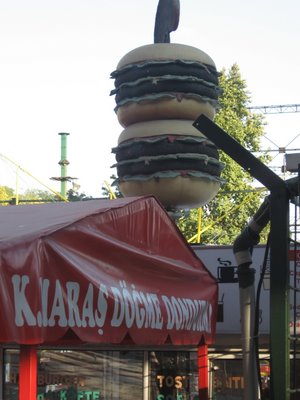 But it was all a sham. No burgers, only köfte. Up at Taxim Square, you could always find something called sosli hamburger - the saucy burger.
But it was all a sham. No burgers, only köfte. Up at Taxim Square, you could always find something called sosli hamburger - the saucy burger. I couldn't bring myself to try them. That's right, I'll happily munch lamb heads or whole dried fish any time of the day, but mass-produced shiny orange hamburgers dripping with yellow sauce kept warm under heat lamps all day... I just couldn't. I kept approaching the burger stand, thinking go ahead... it might be a Turkish version of White Castle... just think of what you'd be missing... but I couldn't. I have failed. The best available alternative would be a pleskavica:
I couldn't bring myself to try them. That's right, I'll happily munch lamb heads or whole dried fish any time of the day, but mass-produced shiny orange hamburgers dripping with yellow sauce kept warm under heat lamps all day... I just couldn't. I kept approaching the burger stand, thinking go ahead... it might be a Turkish version of White Castle... just think of what you'd be missing... but I couldn't. I have failed. The best available alternative would be a pleskavica: 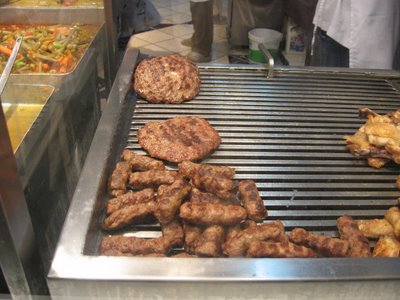 Pleskavica is probably Europe's only viable hamburger substitute. Originally the Yugoslav national burger - pleskavica and accordion music seem to be the only thing that Serbs and Bosnians can agree on - they are usually made from the same beef and lamb combination that goes into cevapcici (seen in the foreground.) Unlike a hamburger, the ground meat is heavily worked by hand into a dense paste before grilling (the secret to a good burger is just the opposite: the burger patty should be handled as little as possible before smacking it down on the grill.) Pleskavica was brought to Istanbul by waves of Bosnian refugees in the 1990s. It is served, however, on a plate with salad and pilav. And the one pictured here isn't gigantic. Serbian pleskavica are the size of hubcaps, literally. Three bucks in a downtown Belgrade restauarant gets you a slab of meat the size of a grilled laptop computer. Slap it inside a flat lepenje bread, spread on some cream kaymak, ajvar pepper sauce andchoppedd onions on it and you have the Balkan equivalent of the House Burger Special. The
Pleskavica is probably Europe's only viable hamburger substitute. Originally the Yugoslav national burger - pleskavica and accordion music seem to be the only thing that Serbs and Bosnians can agree on - they are usually made from the same beef and lamb combination that goes into cevapcici (seen in the foreground.) Unlike a hamburger, the ground meat is heavily worked by hand into a dense paste before grilling (the secret to a good burger is just the opposite: the burger patty should be handled as little as possible before smacking it down on the grill.) Pleskavica was brought to Istanbul by waves of Bosnian refugees in the 1990s. It is served, however, on a plate with salad and pilav. And the one pictured here isn't gigantic. Serbian pleskavica are the size of hubcaps, literally. Three bucks in a downtown Belgrade restauarant gets you a slab of meat the size of a grilled laptop computer. Slap it inside a flat lepenje bread, spread on some cream kaymak, ajvar pepper sauce andchoppedd onions on it and you have the Balkan equivalent of the House Burger Special. The 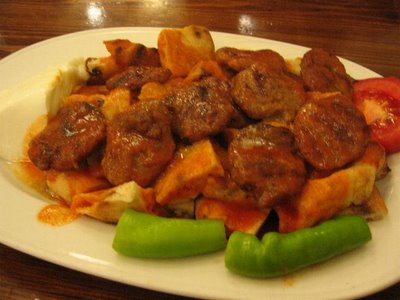 Pideli köfte from the Çiçek Köfte chain: miniature köfte burgers on a bed of soft pide bread in a tomato salça sauce with a side of yoghurt. Of course, I can always run down to the original Çiçek Köfte joint in Karaköy, located on the second floor above a pharmacy in the hardware market:
Pideli köfte from the Çiçek Köfte chain: miniature köfte burgers on a bed of soft pide bread in a tomato salça sauce with a side of yoghurt. Of course, I can always run down to the original Çiçek Köfte joint in Karaköy, located on the second floor above a pharmacy in the hardware market: The straightforward köfte lunch at 2 Euros a plate. Pepper salça, mashed potato, pilav, bread. One of the best lunch buys in the entire universe.
The straightforward köfte lunch at 2 Euros a plate. Pepper salça, mashed potato, pilav, bread. One of the best lunch buys in the entire universe.  Çiçek Köfte is possibly one of my top five köfte restaurants. Like any good restaurant, the staff remains constant and is proud of their work. I first ate at Çiçek in 1991 and the same waiters are still there fifteen years later. Real professionals. Amazingly smart service. When I want a burger it is reassuring to have it prepared somebody who spends decades grilling meats. This isn't fast food, although in terms of minutes, it is.
Çiçek Köfte is possibly one of my top five köfte restaurants. Like any good restaurant, the staff remains constant and is proud of their work. I first ate at Çiçek in 1991 and the same waiters are still there fifteen years later. Real professionals. Amazingly smart service. When I want a burger it is reassuring to have it prepared somebody who spends decades grilling meats. This isn't fast food, although in terms of minutes, it is. But still... it's not a burger.
But still... it's not a burger.

 And their heads taste so good, too! Crack their little skulls, scoop out those tasty brains! Roast those babies up!
And their heads taste so good, too! Crack their little skulls, scoop out those tasty brains! Roast those babies up!  Given that thousands of lambs are slaughtered every morning to feed Istanbul's lamb-hungry masses, it is no wonder that there are quite a few leftover parts after the legs and ribs are spoken for. One of the most sought after tidbits is the head.
Given that thousands of lambs are slaughtered every morning to feed Istanbul's lamb-hungry masses, it is no wonder that there are quite a few leftover parts after the legs and ribs are spoken for. One of the most sought after tidbits is the head.  You might not think of lamb head as a fast food, but there are some people - many of them in Anatolia - who might dispute this with you. This is the lamb head man at the end of our street in Karaköy. He did a booming business with the banking crowd at lunchtime. Strip the lamb meat from the heads, mix it with chopped onion, parsley and pepper, chop in some hard boiled eggs (I never quite understood that part) and drop it into a french loaf. Presto! The ultimate businessman's lunch.
You might not think of lamb head as a fast food, but there are some people - many of them in Anatolia - who might dispute this with you. This is the lamb head man at the end of our street in Karaköy. He did a booming business with the banking crowd at lunchtime. Strip the lamb meat from the heads, mix it with chopped onion, parsley and pepper, chop in some hard boiled eggs (I never quite understood that part) and drop it into a french loaf. Presto! The ultimate businessman's lunch.  Of course, if you prefer a sit down meal you can always drop by your neighborhood tandir joint. Roast lamb heads served with freeshly baked Anatolian pide breads.
Of course, if you prefer a sit down meal you can always drop by your neighborhood tandir joint. Roast lamb heads served with freeshly baked Anatolian pide breads. 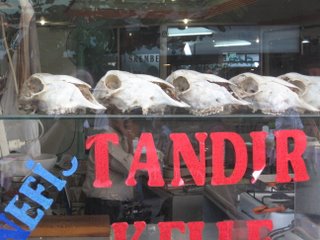 Now that I have you attention and we have broken through the "ewww... gross!" barrier for the day, I feel it is the time to introduce one of the more interesting aspects of Istanbul's medical economy, and one which has its origin in Ottoman times. The leech sellers at the pet market in Eminönu.
Now that I have you attention and we have broken through the "ewww... gross!" barrier for the day, I feel it is the time to introduce one of the more interesting aspects of Istanbul's medical economy, and one which has its origin in Ottoman times. The leech sellers at the pet market in Eminönu.  What? Leeches? Yes, leeches. Leeches are a part of traditional medicine all over the world, and scientists (you know... scientists...) now say that leeches actually do have a very beneficient effect when they suck your blood. Apparently, leech saliva contains a peptide called hirudin, which is a highly effective anticoagulant, and for this reason leeches have come back into clinical practice in the last 25 years. In the Istanbul market they are advertised for their effectiveness in treating eczema and rheumatism. Let's get a closer look, then, at Our NewFriend, The Leech.
What? Leeches? Yes, leeches. Leeches are a part of traditional medicine all over the world, and scientists (you know... scientists...) now say that leeches actually do have a very beneficient effect when they suck your blood. Apparently, leech saliva contains a peptide called hirudin, which is a highly effective anticoagulant, and for this reason leeches have come back into clinical practice in the last 25 years. In the Istanbul market they are advertised for their effectiveness in treating eczema and rheumatism. Let's get a closer look, then, at Our NewFriend, The Leech. 
 Fork over ten bucks for the pastrami. Don't ask questions. Just do it. Ten bucks for pastrami... actually it costs more these days. But who cares? It's Katz's! With luck you may have room left over for a hot dog or a knish. And maybe a nice glass tea? I miss pastrami. I have learned to cure my own corned beef at home here in Budapest, but the spicing and smoking that goes into pastrami means I don't often get to eat the Cold Cut That God Eats For Lunch.
Fork over ten bucks for the pastrami. Don't ask questions. Just do it. Ten bucks for pastrami... actually it costs more these days. But who cares? It's Katz's! With luck you may have room left over for a hot dog or a knish. And maybe a nice glass tea? I miss pastrami. I have learned to cure my own corned beef at home here in Budapest, but the spicing and smoking that goes into pastrami means I don't often get to eat the Cold Cut That God Eats For Lunch.  Where does pastrami come from? Is it even a "Jewish" food? Like a lot of food we identify as Jewish, pastrami is a food that was adopted by Jews and has gone through a radical transformation in the immigration process. Originally, Romanian Jews brought the idea of pastrami with them when they came to the US. In Moldavia pastrama is usually a cured, semi-dry smoked meat, usually made from sheep, that can stay unrefrigerated for months. Jews possibly cured their own kosher pastrama as a food that could be carried along on trips where no kosher meat would be available, kind of like kosher beef jerky - chewing on old truck tires is one way to describe the texture for Moldavian peasant pastrama. One way to make the dried pastrama palatable is to steam it. Another is to slice it thin. Today, Romanian pastrama is sold in supermarkets packaged like any cold cut.
Where does pastrami come from? Is it even a "Jewish" food? Like a lot of food we identify as Jewish, pastrami is a food that was adopted by Jews and has gone through a radical transformation in the immigration process. Originally, Romanian Jews brought the idea of pastrami with them when they came to the US. In Moldavia pastrama is usually a cured, semi-dry smoked meat, usually made from sheep, that can stay unrefrigerated for months. Jews possibly cured their own kosher pastrama as a food that could be carried along on trips where no kosher meat would be available, kind of like kosher beef jerky - chewing on old truck tires is one way to describe the texture for Moldavian peasant pastrama. One way to make the dried pastrama palatable is to steam it. Another is to slice it thin. Today, Romanian pastrama is sold in supermarkets packaged like any cold cut. 
 The paste today contains a lot of cumin and hot paprika, so the meat becomes quite spicy. Pastirma didn't taste anything like I had expected - understandable when you remember that my taste buds were trained on the grease-and-black-pepper pastrami of the Bronx. This was pastirma from Anatolia. It was a truly mediterranean combination of sour, salty, spicy, and savory. Kind of like what stuffed olives would taste like if olives had legs and said moooooo.
The paste today contains a lot of cumin and hot paprika, so the meat becomes quite spicy. Pastirma didn't taste anything like I had expected - understandable when you remember that my taste buds were trained on the grease-and-black-pepper pastrami of the Bronx. This was pastirma from Anatolia. It was a truly mediterranean combination of sour, salty, spicy, and savory. Kind of like what stuffed olives would taste like if olives had legs and said moooooo. 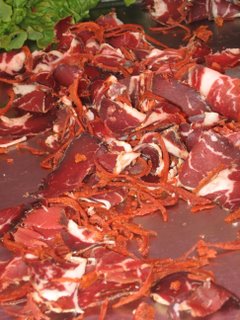
 Subsequently, pastirma is not cheap. A kilo goes for about EURO 20, making it one of the most expensive of meze. But then, meze is how you inpress people, isn't it? And at Namli Pastirmaci in the market behind the Egyptian Spice market in Istanbul, impressing people comes easy. How about a bit of salad to go? Cold stuffed peppers?
Subsequently, pastirma is not cheap. A kilo goes for about EURO 20, making it one of the most expensive of meze. But then, meze is how you inpress people, isn't it? And at Namli Pastirmaci in the market behind the Egyptian Spice market in Istanbul, impressing people comes easy. How about a bit of salad to go? Cold stuffed peppers? 

 In June, I finally got to take Aron on his first trip to Transylvania. I had to pick up some vioara cu goarne (Romanian trumpet fiddles) from Mircea Rostas and Traian Aredelean in Bratca, and this was Aron's first visit to a Gypsy village.
In June, I finally got to take Aron on his first trip to Transylvania. I had to pick up some vioara cu goarne (Romanian trumpet fiddles) from Mircea Rostas and Traian Aredelean in Bratca, and this was Aron's first visit to a Gypsy village.  These are essentially resonator fiddles - a metal membrane takes the string vibrations from the brige of the fiddle to the trumpet bell attachted to the body.
These are essentially resonator fiddles - a metal membrane takes the string vibrations from the brige of the fiddle to the trumpet bell attachted to the body.  The result is a screaming, loud tone, great for playing in one direction in a noisy environment. At dances or fairs, groups of three or more fiddlers will play while swinging their fiddles around for doppler effects. Just up from Bratca, we stayed at a bungalow camp in Negreni. It was late so dinner was kolbasz grilled on sticks over a fire. Aron mastered the finer points of fly fishing...
The result is a screaming, loud tone, great for playing in one direction in a noisy environment. At dances or fairs, groups of three or more fiddlers will play while swinging their fiddles around for doppler effects. Just up from Bratca, we stayed at a bungalow camp in Negreni. It was late so dinner was kolbasz grilled on sticks over a fire. Aron mastered the finer points of fly fishing...  Aron was in pizza heaven. About 20% of Romanians under thirty have worked abroad, mostly in Italy, and mostly in construction and restaurants. One thing they have brought back to Romania is the ability to make a pizza that doesn't resemble a red frisbee that has partially melted on wonderbread (ahhh... Hungary...) As a result, many Romanian towns can rival the Bronx when it comes to pizza.
Aron was in pizza heaven. About 20% of Romanians under thirty have worked abroad, mostly in Italy, and mostly in construction and restaurants. One thing they have brought back to Romania is the ability to make a pizza that doesn't resemble a red frisbee that has partially melted on wonderbread (ahhh... Hungary...) As a result, many Romanian towns can rival the Bronx when it comes to pizza. Romania was the tail end of my Atkins phase, and of course, Romania is a very Atkins friendly land. Mici also called mititiei, Romania's answer to köfte, albeit a rather abrupt and garbled answer. Beef neck and mutton ground and grilled, served everywhere with mild, bright yellow mustard and bread. The lunch of the nation.
Romania was the tail end of my Atkins phase, and of course, Romania is a very Atkins friendly land. Mici also called mititiei, Romania's answer to köfte, albeit a rather abrupt and garbled answer. Beef neck and mutton ground and grilled, served everywhere with mild, bright yellow mustard and bread. The lunch of the nation. 
 Personally, I like the image of a davul drummer blasting away on the box. During Ramadan drummers (davular) and musicians alert everybody to the fact that "it's chow time!" There were huge Ramadan feast shacks being built in Fatih as we were leaving, in expectation of the late night chow hounds coming to celebrate "the fast."
Personally, I like the image of a davul drummer blasting away on the box. During Ramadan drummers (davular) and musicians alert everybody to the fact that "it's chow time!" There were huge Ramadan feast shacks being built in Fatih as we were leaving, in expectation of the late night chow hounds coming to celebrate "the fast." During our last day shopping in Istanbul - ("shopping" means buying little bracelets for US 30 cents) we met a shop keeper who specialized in Uzbek Suzani textiles. This particular guy spoke fluent Romanian... he had studied a couple of years in Bucharest. Turks beat the Dutch in multilingualism. We were able to happily converse in the Wallachian form of Swamp Latin for while, but we didn't buy anything. Fumie is Hungary's #1 Suzani collector and expert, so pretty soon she was in the midst of.... cosplay
During our last day shopping in Istanbul - ("shopping" means buying little bracelets for US 30 cents) we met a shop keeper who specialized in Uzbek Suzani textiles. This particular guy spoke fluent Romanian... he had studied a couple of years in Bucharest. Turks beat the Dutch in multilingualism. We were able to happily converse in the Wallachian form of Swamp Latin for while, but we didn't buy anything. Fumie is Hungary's #1 Suzani collector and expert, so pretty soon she was in the midst of.... cosplay We had to leave today, so Fumie picked up a few pieces of sliced smoked bonito, aka palamut:
We had to leave today, so Fumie picked up a few pieces of sliced smoked bonito, aka palamut: And some dried red mullet eggs encased in wax, the same stuff the Italians worship as bottarga... pretty damn cheap.
And some dried red mullet eggs encased in wax, the same stuff the Italians worship as bottarga... pretty damn cheap.  My last meal in Istanbul.... inegol kofte at our favorite place near Tunel:
My last meal in Istanbul.... inegol kofte at our favorite place near Tunel: On the plane home, we took a nice take-out order of burek... why deal with crap Malev sandwiches?
On the plane home, we took a nice take-out order of burek... why deal with crap Malev sandwiches?  If anybody isinterested, the skinheads in Bpest seem quiet tonite. We'll keep you updated. And we will continue to torture Transylvanians...
If anybody isinterested, the skinheads in Bpest seem quiet tonite. We'll keep you updated. And we will continue to torture Transylvanians...